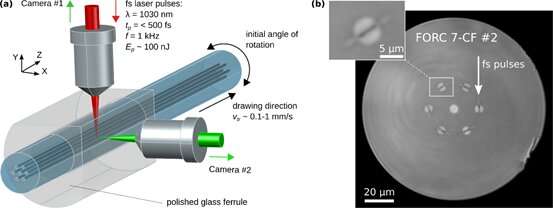Advances in femtosecond laser direct writing of fiber Bragg gratings in multicore fibers

A new publication in Opto-Electronic Advances overviews advances in femtosecond laser direct writing of fiber Bragg gratings in multicore fibers.
In recent years, multicore optical fibers have significantly contributed to the rapid development of technologies for high-capacity data transmission over optical communication links, high-power fiber lasers and amplifiers, as well as new types of optical sensors. A fiber Bragg grating (FBG)—an element that reflects light at a certain resonant wavelength given by the period of the refractive index structure—plays a key role when developing devices based on such fibers.
Among the existing methods of FBGs writing, the direct writing technology using femtosecond laser pulses in the visible or infrared spectral range seems to be the best candidate when dealing with multicore fibers. Due to the nonlinear nature of femtosecond pulse absorption, this technology allows not only to inscribe an FBG in a selected core, but also implement it through a protective coatings of the fiber such as polyimide and acrylate. By controlling the position of the refractive index modification region in the cross section of the multicore fiber, as well as the laser pulse energy, an FBG with predefined geometric and spectral properties can be inscribed in the required transverse (selected core) and axial positions.
The research groups of Prof. Sergey Babin from the Institute of Automation and Electrometry of the SB RAS (Novosibirsk, Russia), and Prof. Stefan Wabnitz from Novosibirsk State University (Russia) and Sapienza University of Rome (Italy) have reviewed recent advances in this field and present their experimental results on the selective inscription of FBGs in multicore fibers using infrared femtosecond laser pulses, as well as on the use of the fabricated structures in real applications in this article. In particular, the multicore fiber shape sensors and a fiber Raman lasers developed by the authors are considered.
The possibility of spatial separation of optical signals makes multicore optical fibers attractive for the development of sensors that measure multi-parameter physical impacts on the fiber. When reviewing advances in sensors, emphasis is made on 3-dimensional shape sensors, which are in demand in microrobotics (in particular, minimally invasive surgery), aerospace industry, and monitoring the structural health of industrial facilities, thanks to their compactness, flexibility, chemical inertness and electromagnetic insensitivity.
Multicore fiber is also a promising medium for the development of high-power fiber lasers and amplifiers, since in this case the influence of nonlinear effects (stimulated Raman and Brillouin scattering, self-phase modulation, mode instability, etc.) on the lasing regime becomes weaker due to an enlargement of the net area of the core modes.
The femtosecond laser technology of refractive index modification inside transparent materials offers a high degree of freedom when operating with multicore optical fibers. Besides fiber Bragg gratings, complex optical integral elements for spatial division multiplexing communications, components for measuring physical quantities and biosensors, as well as complex sets of Bragg mirrors for laser systems can be fabricated with the technology.
To date, the research and development of multicore fiber sensors for measuring curvature, torsion and shape demonstrates high measurement accuracy when using various methods, which are most appropriate for each case. The next steps in their development will be focused on combining the best solutions in terms of balance of accuracy, performance and cost in a single device. In addition to the reconstruction of shape, it is promising to add other independently measurable distributed parameters such as temperature, vibration, pressure etc.
Multicore fiber lasers with intracore FBGs demonstrate interesting spectral features, resulting from the effective mode area enlargement and interference effects arising from the coupling of radiation reflected from FBGs inscribed in different cores. A further increase of the core number in active and passive fibers and corresponding number of FBGs inscribed into the cores would be of interest for both power scaling as well as for line narrowing. For the sake of power scaling of both conventional and Raman-type amplifiers and lasers based on active and passive multicore fibers, respectively, it is especially important to explore the possibility of pump coupling into the fiber cladding, similar to conventional high-power single-mode fiber lasers using a double-clad fiber structure.
More information: Alexey Wolf et al, Advances in femtosecond laser direct writing of fiber Bragg gratings in multicore fibers: technology, sensor and laser applications, Opto-Electronic Advances (2022). DOI: 10.29026/oea.2022.210055
Provided by Compuscript Ltd





















